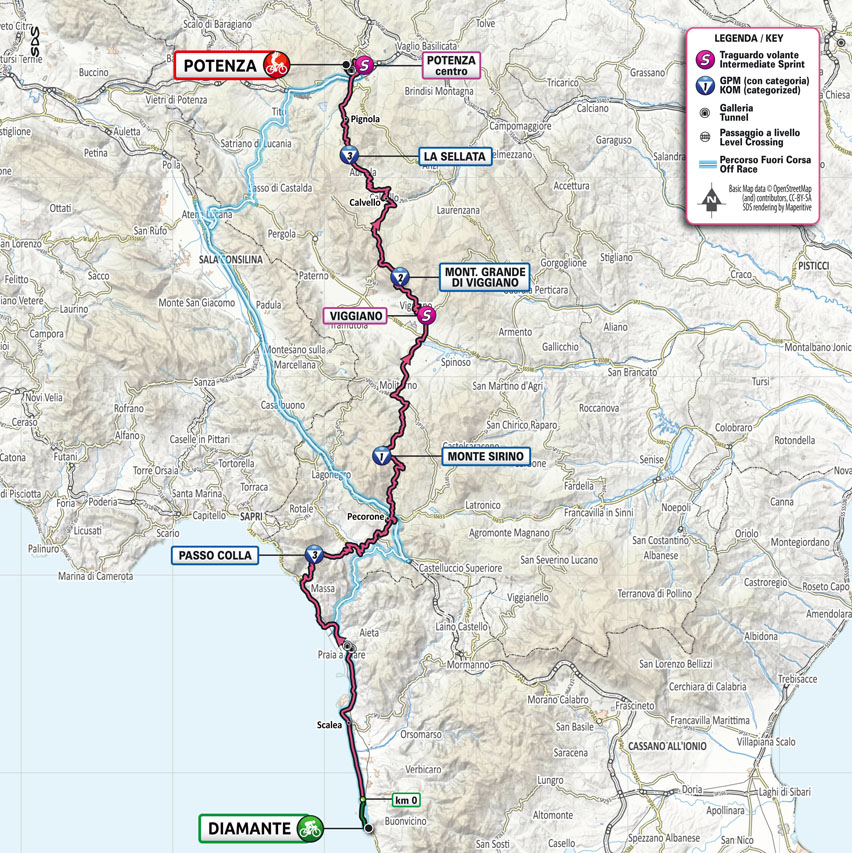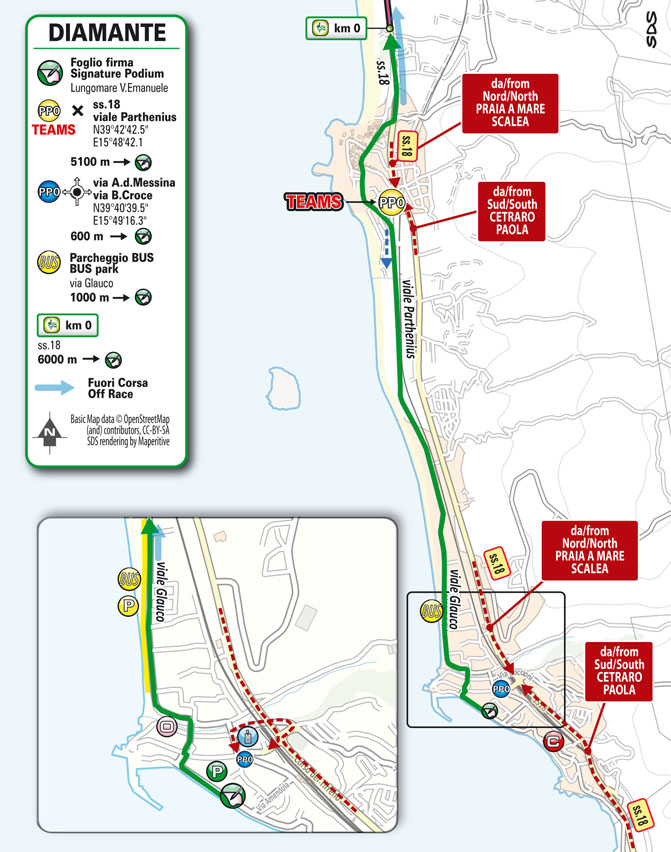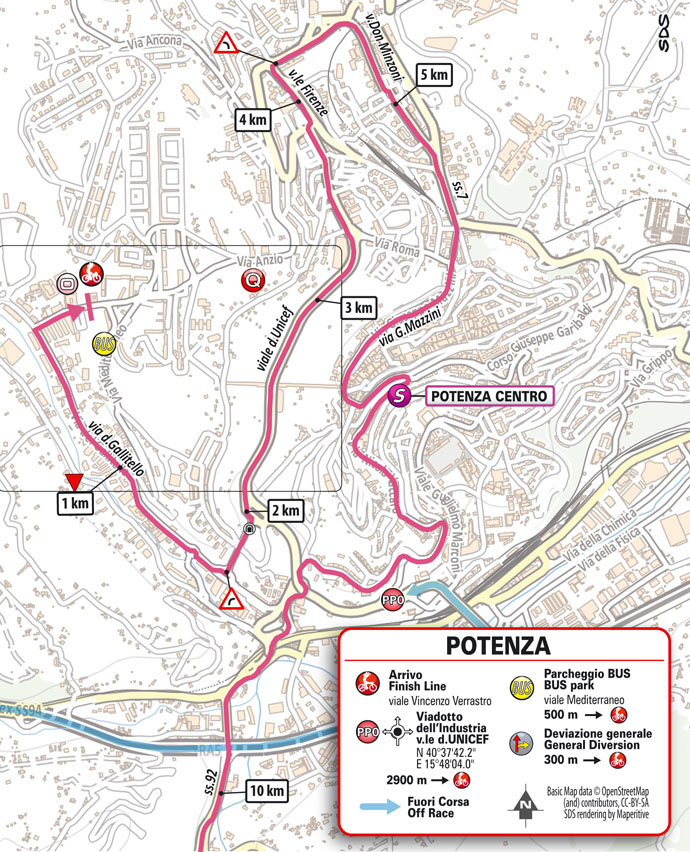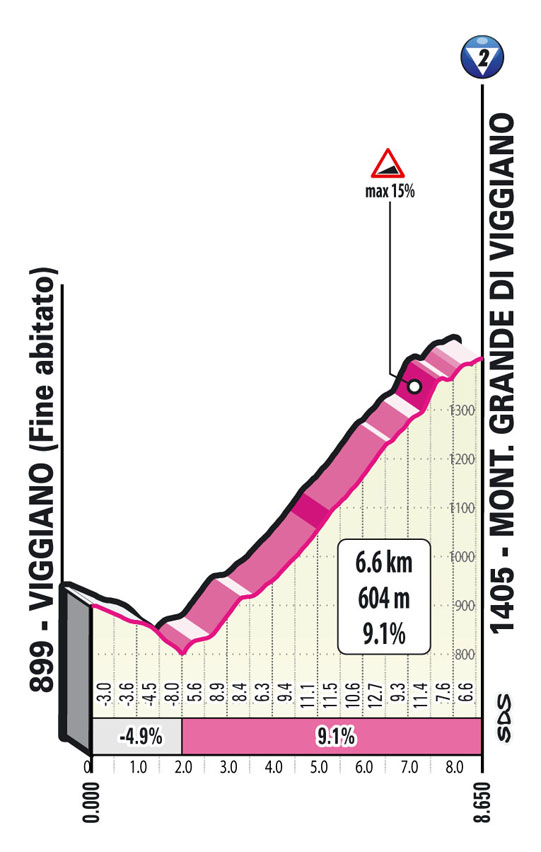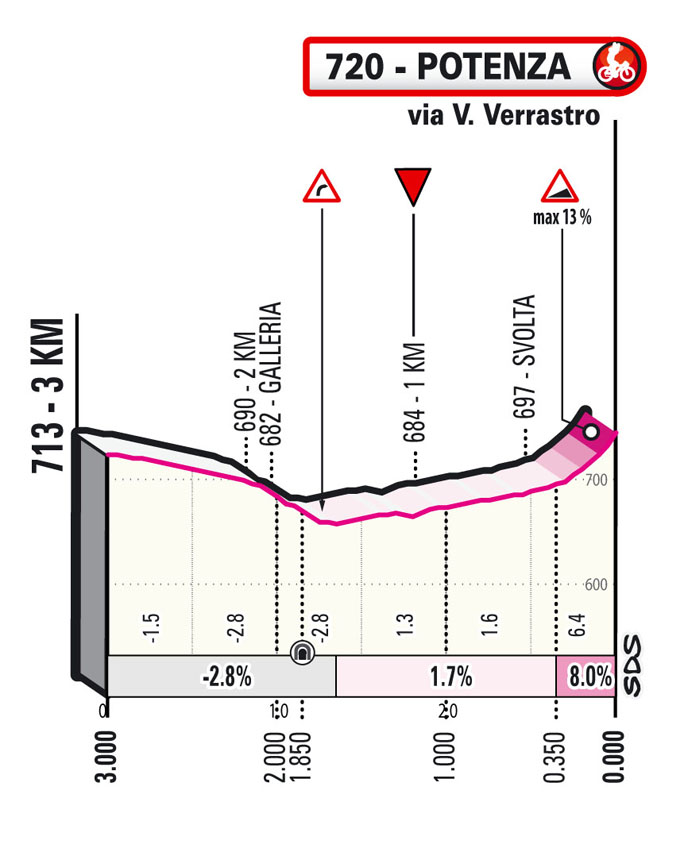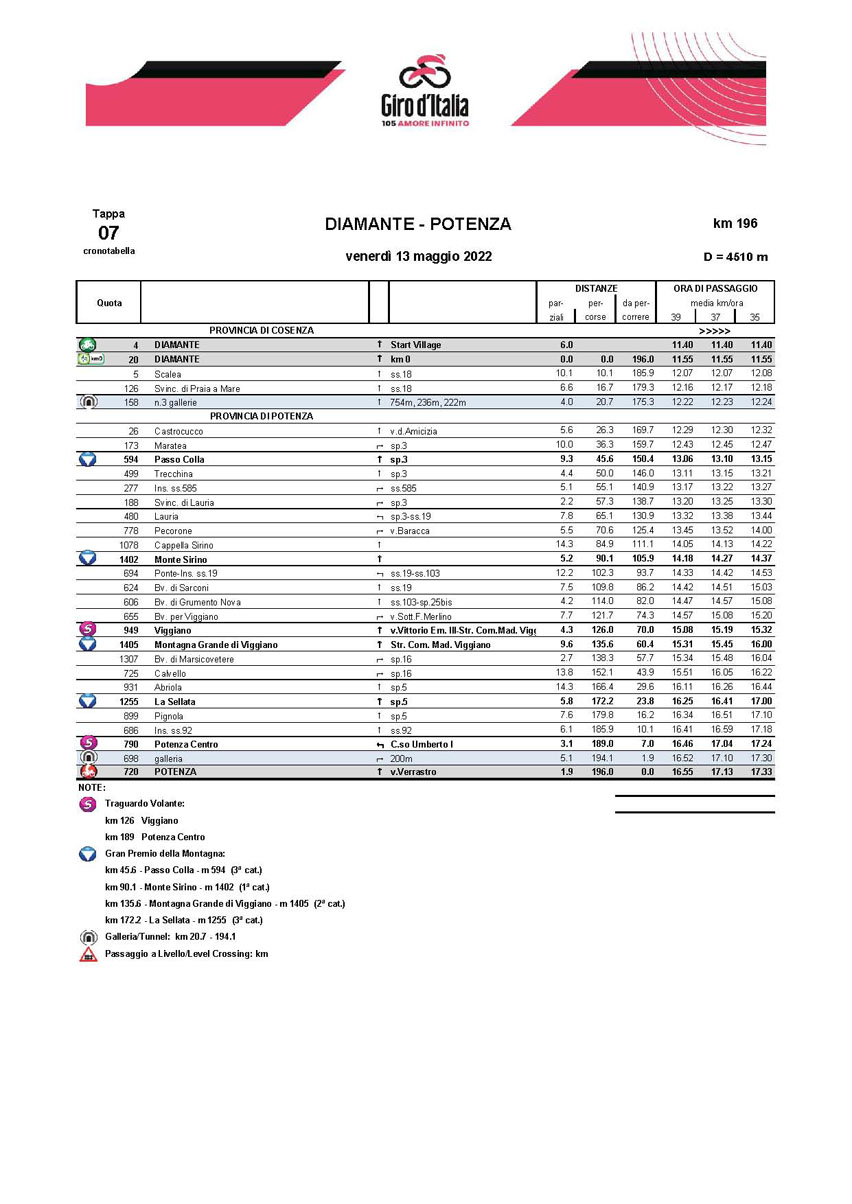profile
map
technical info
The route
A very challenging stage across the Southern Apennines. The start along the sea is the only flat stretch. Past Maratea, the route undulates continuously, with milder or harsher gradients. After climbing the Passo della Colla and reaching Lauria, the stage tackles the Monte Sirino. The route then hits Viggiano, clears the challenging Montagna Grande di Viggiano, and then takes in the final ascent of Sellata before reaching Potenza. Throughout the course, the roads are usually narrow and can be damaged at points, twisting continuously along the mountainside.
Final kilometres
The final kilometres are raced entirely on urban roads. The route runs uphill across the inner city, with sharp gradients at points, and then descends along wide and well-paved avenues. There is a short tunnel at the ‑2 km marker, leading into the finish avenue. The last 350 m have an average 8% gradient, topping out at 13%. The finish sits on tarmac.
start / finish
climb detail
final kilometres
itinerary timetable
tourist info
Host city:
Diamante
Touristic Information
Diamante: a treasure that needs to be discovered Diamante is a lovely town in the province of Cosenza. It is located in one of the most picturesque areas in the north tirrenic cost. This area is called “Riviera dei cedri” because of the huge cultivation of citrus ( in Italian “cedro”). Diamante is a candidate for the Capitale Italiana della Cultura 2024 contest – in English “Italian Capital of Culture”. It has already won the Blue Flag, synonym of clean bathing water and of a beach suitable for all tourists. Diamante is in fact loved by everyone who sees its crystal clear sea and its magical sunset. Moreover, Diamante has an always mild weather which attracts tourists of all ages. It is known as the “Town of the Murals”: it has more than 300 murals. As a result, Diamante seems an actual museum. It is also known as the “Capital of the chilly pepper” – called Peperoncino in Italian. The “Peperoncino Festival”, a gastronomic and cultural event, takes place here every year in September, managed by the Italian Academy of Chilly Pepper (Accademia Italiana del Peperoncino): this festival is going to celebrate its 30th anniversary in 2022. However, Diamante has another particularity: Cirella, a little village that is part of its territory, offers outstanding historical and archaeological treasures. Furthermore, the little marvelous island in the sea in front of Cirella is named after this town. Diamante is breathtaking under every aspect.
Gastronomy
The typical gastronomy of the town is rich and varied: you can taste fish and sea-food dishes as well as rural dishes. Every dish is always topped with a little bit of chilly pepper, mostly with the one called “Diavolicchio Diamante”, that is a local type of this spice. There are several unique dishes ideal to be tasted by tourists: first of all, one of the most famous dishes is “la Raganella”, the perfect match between sea food and chilly pepper: it has a round shape and it is made of bread, chilly pepper and bluefish. Secondly, you could taste salt anchovies and chilly pepper with salad. Otherwise, if you don’t like this spicy taste, there are dishes made of a local variety of citrus, the one called “Liscia Diamante”, needed by Jews, too, during their Feast of Tabernacles. Citrus is used to make liquors and ice creams, as well as “I panicilli di d’Annunzio” , a dish with raisins named after the poet who loved it.
Beverages
Diamante and its long tradition of wines and liquors. Diamante collaborates with Verbicaro, a nearby town, in the production of a wine that boasts the “domination of controlled origin”. Cirella has an important relationship with wine, too. Andrea Bacci, author of the book “de Naturali Vinorum Historia” (1595) named Cirella “Vinipoli”, city of the wine. Some centuries ago, “il Chiarello di Cirella”, a sweet wine, was famous because it was liked by Pope Sisto V. The bottler of Pope Paolo III, the historian and geographer Lancerio Sante, said that this wine was “giallo come l’oro et odorisissimo assai – yellow as gold and very well-scented”. This famous wine was probably made from a type of grapes called “Adduraca”, a word similar to the dialectal term for “perfume”. Lately, they succeeded in making it again and whoever tries it, loves it. Moreover, the Association “Cerillae” organizes every year in July and August the festival “Calici Sotto le Stelle”, to enhance every oenological excellences. This event will celebrate its 13th anniversary in 2022.
Main sights
I MURALES
Diamante is known as the city of murals or “the city of noses that go up”. The idea of murals was born in 1981 thanks to the mayor Evasio Pascale and the artist Nani Razzetti. Eighty – five artists from all over the world came to paint every wall in town. The subject painted were various: the women’s emancipation painted by Eva Krump, the war painted by Ibrahim Kodra, the maritime tradition painted by Guglielmo Siepa, the rural tradition painted by Massimo Paterna and even an autographed masterpiece by Dacia Maraini. In the next years, thanks to the many Operations Murales, Diamante reached a number of over 300 murals. In 2017, the artist Antonino Perrotta started the festival OSA-Operation street Art, succeeding in adding new murals with the collaboration of other international artists like Sfhirm, Tony Gallo, Kraser and Jorit.
I RUDERI DI CIRELLA
At 172 meters above sea level, you can find the ancient Cerillae, a little town born around 1000 A.D. and destroyed three times in history. After the last plundering, the citizens looked for a place to live in the nearby territories. We can still appreciate the ruins of the castle and of the “San Nicola Magno” church.
MONASTERO DEI MINIMI DI CIRELLA
Built by the order of Minims in 1545, this monastery was consecrated to St. Francis of Paola. However, it was abandoned in 1810. In 2018, thanks to a renovation, the building was brought to new life. Now, either religious ceremonies or artistic events takes place here. The ancient cluster and the rooms that used to be the monk’s cells are accessed from the central nave.
TEATRO DEI RUDERI DI CIRELLA
Between Cirella’s ruin and the monastery, there’s been, since 1994, the Theatre of Ruins: built in greek style, it is an open space where you can enjoy concerts and plays.
CHIESA DELL’IMMACOLATA CONCEZIONE
Built in the XVII century, this church has only one nave. It has a precious baptismal font. Prince Tiberio Carafa gave to the church a monumental statue of the Immaculate Conception, dating from around 1656, two meters high and carved out of an olive tree trunk.
CHIESA GESU BUON PASTORE
La posa della prima pietra è datata 3 Febbraio 1984, giorno delle celebrazioni di San Biagio cui è intitolata la parrocchia cui appartiene la Chiesa. Al suo interno, i dipinti di Nani Razetti raffiguranti la Via Crucis e, sulla pala dell’altare maggiore, L’Ultima Cena.
The laying of the fist stone took place on February 3rd, 1984. In this day, Saint Biagio, to whom the parish is entitled, is celebrated. Inside, there are paintings made by Nani Razzetti representing “la Via Crucis” and there is a painting depicting “The Last Supper” near the high altar.
CHIESA SANTA MARIA DEI FIORI
In the inside, you can see roman columns, memorials of the family Catalan Gonzaga, holy water fonts made from local stones, paintings from the XV and the XVI centuries, even a wooden statue from Cirella Vetere of the Madonna dei Fiori, totally renovated in 1996.
LUNGOMARE DI DIAMANTE
Built in 1965 and located on the south cost, at 20 meters above sea level, it can be seen as the “living room” of the town.
Potenza
Touristic Information
The capital of Basilicata for over two centuries, Potenza is the highest regional capital in Italy at 819 metres above sea level. Elegant and welcoming, the city revolves around its thousand-year-old historic centre, made up of old and new buildings that climb up on the hill, ancient gateways and medieval towers, historic stone staircases and modern escalators, stately palaces and authentic little squares, narrow alleys and cobbled streets, as well as museums and art galleries, such as the “Dinu Adamesteanu” National Archaeological Museum, housed in the historic Palazzo Loffredo.
In the central Piazza Mario Pagano, recently renovated on a design by the famous architect Gae Aulenti, stands the theatre dedicated to the Potentine musician Francesco Stabile, built in 1857 in the image of the San Carlo theatre in Naples.
In May, then, the city is enveloped in a magical atmosphere that revolves around the preparations for the celebrations in honour of its patron saint, San Gerardo Vescovo da Piacenza, celebrations that are intertwined with the historic Parade of the Turks, a parade that retraces the crucial moments in history, loudly narrated by entire generations of the capital, which sees the city’s patron saint repel with a blinding glare the invasion of the Turks who silently came up the Basento river.
Gastronomy
Basilicata’s traditional cuisine features a broad variety of specialities: From strascinati, homemade pasta served with tomato sauce or in other delicious and unmissable recipes, to flavourful cheeses, produced by traditional methods, such as Pecorino cheese of Filiano (PDO), Canestrato of Moliterno (PGI), ricotta, scamorza and caciocavallo (gourd-shaped cheese), and to pork sausage, such as the “lucanega” variety, already known in ancient Rome. Matera bread (PGI), with its fragrant flavour and characteristic shape that reminds Murgia landscapes, is really worth trying. Other delicious specialties include: black, oven-dried olives from Ferrandina area, baccalà (dried salt-cured cod) from Avigliano, optimum mineral waters from the springs of Mount Vulture, Rotonda red eggplant PGI, Sarconi bean PGI and Senise pepper PGI. Fresh seasonal fruit is a recurrent motif on the table: citrus fruits, strawberries, peaches, pears and grapes are only some of the varieties cultivated on the plains around Metaponto.
Beverages
In Basilicata, when you sit down to eat, you combine the flavour of unique specialties, seasoned with a drizzle of “Vulture” DOP Extra Virgin Olive Oil, with a delicious, full-bodied, intense and smooth wine. In fact, one of the best wines in southern Italy comes from the hills of Vulture: Aglianco del Vulture DOC.
The origins of this fine wine, which today is counted among the best in Italy and Europe, date back to the times of Magna Graecia. The vineyards are located on the slopes of Monte Vulture, an extinct volcano that gives the wine its unique and distinctive character. Aglianico del Vulture, whose “Superiore” variety was awarded DOCG status in 2010, is the perfect accompaniment for the highly regarded local cuisine and strong traditional flavours.
Basilicata boasts 3 other wines bearing the DOC mark and well representing the regional variety: “Terre dell’Alta Val d’Agri” wine, produced in the Val d’Agri district and available in Red, Red Riserva and Rosè varieties; “DOC Matera”, which takes its name from the town of Sassi but is also produced throughout the province, from the Ionian Coast to the Murgia gorges; “Grottino di Roccanova”, named after the ancient caves where the wine is traditionally aged.
Main sights
POTENZA – The “Dinu Adamesteanu” National Archaeological Museum
The Museum is located in the prestigious Palazzo Loffredo, the most important historical building in Potenza, which also houses the Municipal Gallery and the Celestine Chapel.
Dedicated to Dinu Adamesteanu, a scholar of international renown and the “founder” of Lucanian archaeology, the museum is an important showcase for the regional museum network, consisting of eight national archaeological museums, to which the exhibition on the first floor is dedicated.
At the entrance you can admire the exhibitions: “Dinu Adamesteanu, the man and the archaeologist. From Dobruja on the Black Sea to Siritide on the Ionian Sea” and “Invitation to the Prince’s House. Archaeology in Tito, Satriano Tower”.
POTENZA – The Provincial Archaeological Museum
The museum exhibits archaeological finds from excavations in Basilicata with findings dating from prehistoric to late Roman times and extending into the Middle Ages.
On the ground floor it is possible to visit the archaeological exhibition “The eternal renewal of life; signs and symbols” with artefacts from the Neolithic to the Middle Bronze Age, from the Latronico Caves, and to admire part of an aedicula funerary stele with an Oscan inscription in Greek characters, from Anxia (Anzi).
The inner garden hosts a significant exhibition of the Lapidarium, with honorary and funerary inscriptions in Latin related to the Roman Potentia of the period between the Republican and Late Antique periods.
POTENZA – The Cathedral of San Gerardo
Built in 1197, the cathedral dedicated to the city’s patron saint stands on the remains of an early Christian basilica. Its current neoclassical appearance dates back to the end of the 18th century, designed by architect Antonio Magri, a pupil of Vanvitelli.
The main façade is very beautiful, with a fine portal with two bronze doors and a small rose window, probably belonging to the older church, dedicated to Our Lady of the Assumption until the middle of the 13th century.
The cathedral has a Latin cross plan with a single nave and ten chapels distributed around its perimeter, including one dedicated to Saint Gerardo la Porta di Piacenza, the patron saint of Potenza.
Upon entering this beautiful temple, one’s gaze is drawn to the exquisite frescoes decorating the vault by painter Mario Prayer (1933-1934). The crypt of the high altar is also of particular interest.
POTENZA – The Teatro Stabile
Listed among the region’s artistic places of excellence, the theatre dedicated to the Potentine musician Francesco Stabile was proclaimed a “Lucanian Historical Theatre” in 2014.
The attentive visitor will notice that the theatre was built in 1857 in the image of the San Carlo theatre in Naples. Despite numerous restorations, the building has retained its original decorations that, together with the harmonious interior structures, make it a gem of its kind.
The ground floor, three tiers of boxes and the gallery enclose the orchestra and the stage on which many important cultural events and theatre shows are staged.
POTENZA – The Guevara Tower
The three-storey, twenty-metre-high building is located in the old town centre and is all that remains of an ancient castle (10th-11th century).
Under the Guevara family, counts of Potenza, the castle was donated to the Capuchin friars. In 1810, when the castle was taken away from the monks, it began to undergo numerous changes in its use and structural modifications, until it was completely demolished in the 1960s to allow for the building of a school.
POTENZA – The Musmeci Bridge
A prestigious “gateway” to the city, the bridge is named after the engineer who designed it around the end of the 1960s. Looking at it closely, one immediately realises that it is reductive to call it an “ordinary” bridge and that it would be more correct to consider it as a gigantic and refined sculptural work.
It does not rest on pillars, but on concrete waves forming a single vault and four contiguous arches, and this conformation has allowed internationally renowned artists and sportsmen to perform using the engineering features of this masterpiece of contemporary architecture.
Potenza and its patron saint, San Gerardo La Porta
The patron saint of Potenza, and of its archdiocese, is St Gerardo La Porta, the bishop who is credited by the population with repelling the invasion of the Turks with a blinding glare. Over time, the episode has become the focus of the festivities held every year in honour of the Saint. A parade full of myths and legends that intertwine with historical facts, sometimes to the point of complete confusion, retraces the crucial moments of that event. The historic Parade of the Turks is a travelling performance that fills the streets of the city on 29 May every year, with hundreds of costumed figures playing the roles of the various protagonists of this re-enactment.
































